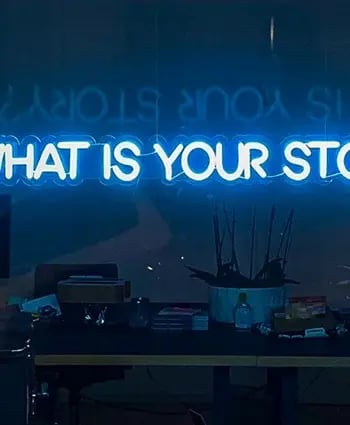Why brand voice matters and how to define yours
How does Apple reflect their easy-to-use products with their brand voice? How did Innocent Smoothies become so loveable?
What is brand voice?
Say you went to a party and one person stands out. The language they use when they communicate, the flow of their words, and their personality is magnetic. It makes for a really memorable experience, and you arrange to meet them again. Now, imagine that person is a brand.
If your brand was a person, what personality traits would they display? And what traits would they actively avoid? What phrases and stylistic choices would it make?
Combining these elements will help to create your brand voice. You can then use it everywhere your brand speaks, be that in adverts, newsletters, social media posts, or official comms like internal company announcements and job adverts.
Why does brand voice matter?
You can only rely so much on your visual content, logo or product features alone to stand out in such a crowded digital world. Your brand voice needs the very same consistency and attention that you give to all your other brand elements.
How you present yourself is important to your target audience. Posting content that doesn't match your brand's usual style could be perceived as irrelevant to your audience, guaranteeing that they won't pay attention. You want your brand to be consistent and recognisable to those more important to your business. Like a familiar friend appearing on their timeline.
How to create your brand voice
Deciding on your brand voice can be tricky. Many brands opt to do what their gut tells them to, instead of making informed, strategic decisions. This can lead to lacklustre comms that play it safe, or that simply portray the personality of their CEO. To get confident with how your brand expresses itself to the world, here are three of Venture's top tips for refining it.
1. Audit your current brand voice
The best place to start is to take a look at your current communications. To get a good overview of what the voice is like currently, pull communications from everywhere your brand speaks and compare them.
Ask yourself:
- Is this voice inconsistent? You may find that different writers use different words.
- How does your target audience interact with you? What words do they frequently use?
- What voice traits do your top-performing posts and newsletters have in common?
From here, you'll be able to note where your brand voice currently stands, and how to make improvements. Artificial Intelligence is increasingly being used by marketing teams to find patterns like this faster. And it's a service we offer here at Venture! Get in touch if you want to learn more.
2. Identify your audience and personas
Another way of nailing your brand voice is by getting familiar with your audience's personas. If your target audience is younger, you won't want to alienate them by using language that relates to an older generation.
As you research your audience, list out traits and common vocabulary you want to take on as a brand. Nottingham's Leftlion Magazine, for example, often takes on local slang in their communications, which keeps things familiar and relatable to their Nottingham-based readers.
Extra tip: You want to present your voice authentically to your audience, so don't just try to jump on new trends as they happen. Dig deep into who your audience is, write in a way that they would speak, and be consistent.
3. Know your tone of voice
Your voice is what you say and your tone is how you say it. The best way to think about this is the way you announce a new product. When you release your product to the world, your tone may come across as excited, which won't be the best tone to take on when responding to a customer complaint.
It's also worth noting that not all tones will work in keeping with your product. For example, Innocent Smoothies can get away with their simple, cheeky, slightly-chaotic tone because well, they sell fruit smoothies, a simply delicious drink that hardly breaks the bank to purchase. If you're selling something that's a big investment like an Apple Macbook, you might opt for a tone that's still honest and authentic, but a little more serious than reeling off jokes about the latest episode of The Great British Bake-off.
Round-up
As long as it's unique and resonates with your brand and audience, your brand voice can be as personality-filled as you like. To get braver with yours, you need to be confident that it's going to resonate with your audience and keep it consistent. So, now you know a little more about brand voice, it's time to create your own. And remember, this document is always a work in progress. It's vital to update it as your business grows and shifts.
Need help creating your brand strategy? We've got you covered. Check out Venture's brand strategy services to help you solidify how your brand speaks to the world, define what makes you remarkable, and become an aspirational brand.
Written by Jonathan English CEO for Venture Videos — a full-service video production agency that specialises in producing creative videos & campaigns that get real results.





